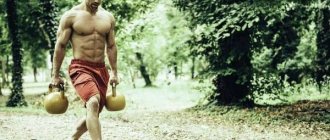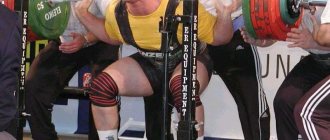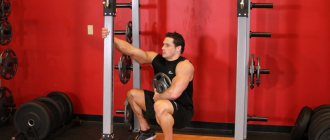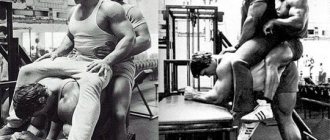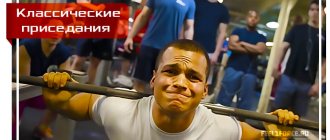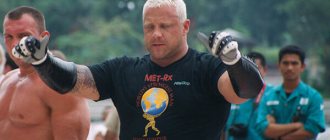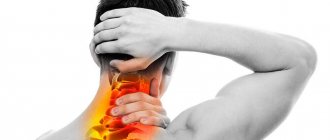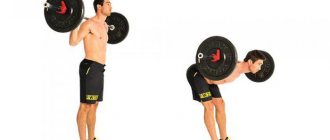Air squats, or air squats, are rightfully considered one of the most popular exercises performed without weights.
They are included both in the main CrossFit program and in the warm-up program. This truly universal basic exercise is useful primarily for beginners.
Despite their apparent simplicity, they require refined technique, and mastering it will help you perform kettlebell squats or jumping exercises in the future.
What muscles are involved?
If you perform the air squat technique correctly, you will use the following muscle groups:
- Gluteus maximus;
- The front and back of the thighs;
- Biceps femoris;
- Calf muscles;
- Posterior muscles of the leg;
- Back and abdominal muscles as stabilizers.
Please note that these muscles work only if the technique is followed during the exercise. Improper execution can lead to dire consequences, especially in the future, when the athlete moves on to squats with weights.
Benefits of squats for men
- Exercise gives an anabolic boost to the development of all muscles of the body. By performing squats, not only the target muscles develop, but also the total body mass increases, including smaller muscle groups.
- Squats increase the production of your own testosterone, a strength hormone that allows you to train with greater strength and load, also accelerating muscle growth.
- Exercise strengthens the cardiovascular system and improves blood circulation.
- Strengthens the ligamentous apparatus.
Pros and cons of squat squats
Squat squats are very important for the body, let's look at what the benefits are:
- The athlete’s endurance threshold increases, which allows for improved standards in sports;
- Adequate exercise trains the cardiovascular system well;
- The lower part of the body takes the main hit, so ladies who want to improve the shape and appearance of their butt and hips, don’t forget about air squats!
- The exercise is performed at a fast pace, which promotes active fat burning;
- The flexibility of joints and ligaments increases, which is extremely important if an athlete plans to learn how to squat with heavy weight;
- The sense of balance is sharpened, coordination of movements improves.
We have talked about the benefits of air squats, then we will briefly discuss in what cases they can cause harm:
- Firstly, if you have joint problems, especially the knees, air squats can aggravate them. Note that in this case, any type of squats is basically contraindicated for the athlete.
- This exercise should not be practiced by overweight people;
- Contraindications also include diseases of the musculoskeletal column, heart, any inflammation, conditions after abdominal surgery, pregnancy.
If an athlete has chronic diseases, we recommend consulting with a supervising physician before starting training.
https://youtu.be/JhGvhPU_qak
Glossary of CrossFit terms and abbreviations
Friends, we tried to collect in this article as many abbreviations, terms and names of exercises that are used in CrossFit. The list will be expanded and replenished; separate articles have been written about some exercises on our website. If you see that some term is missing in our dictionary, write to us and we will add to this list.
A AS (Air Squat) - air squats, squats with your own body weight AMRAP (as many rounds as possible) - complete the maximum number of rounds in the allotted period of time AFAP (as fast as possible) - complete the complex as quickly as possible
B Back Squat - squats with a barbell on the shoulders Barbell - barbell Bear Crawl - bear walk Bench press - bench press BJ (Box Jump) - jumping on a stand Burpee - burpees, burpees BW (BWT, Body weight) - body weight
With C2 (Concept II rowing machine) - concept 2, rowing machine C2B (Chest To Bar Pull-ups) - pull-ups CLN (Clean) - clean C&J (Clean & Jerk) - clean and jerk CrossFit - crossfit , a functional training system based on constantly varying functional movements performed at high intensity. CFT (CrossFit Total, consisting of max squat, press, and deadlift) - a test consisting of basic exercises: squats, bench presses and deadlifts
D Dead Bug - an exercise in which a person lying on his back directs his outstretched arms and legs to the ceiling and simultaneously lowers opposite arms and legs, in pairs, in turn - first the right arm and left leg, then vice versa Death by... - a sequence in which The first minute you perform 1 repetition, the second 2 repetitions, the third 3, etc., until you fit within the allotted minute. Dip - dips DL (Dead Lift) - deadlift DU (Double-Unders) - double jumping rope Db (Dumbbell) - dumbbell
E EMOM (Every Min Of the Min) - perform the exercise every minute for N minutes
F FS (Front Squat) - front squats False Grip - deep grip on rings Floor Wipers - floor polisher
G GPP (General physical preparedness) - general physical preparation (GPP) GHD (Glute-Ham Developer) - lumbar-abs trainer Goblet sguat - squats with holding a weight in front of you GPP (General physical preparedness) - GPP, general physical preparedness
H Hammer Slam - sledgehammer blows Handstand Push-up - handstand push-ups (upside down) Hang Power Clean - hanging clean Hang Power Snatch - hanging snatch Hip Thrust - hip raises with a barbell on the hips Hollow Rock - swing ( simultaneous raising of arms and legs in a position lying on the stomach and swinging) Hook Grip - grip of the barbell in the lock HPC (Hang Power Clean) - pull-up from a hanging position (above the knees) HR Push Ups (Hand-release Push Ups) - push-ups with a lift palms HS (HandStand) - handstand HSPU (Hand Stand Push Up) - push-ups in a handstand (upside down) HSW (Hand stand walk) - walking on hands Hyperextension - hyperextension, an exercise for the development of spinal straighteners, hip flexors and gluteals muscles.
J Jerk - jerk (full cycle - clean and jerk)
K Kettlebell - kettlebell K2E (Knees To Elbows) - knees to elbows KBS (Kettlebell Swing) - kettlebell swings Kipping Pull-ups - kipping pull-ups, with swinging
L L-hold - L-fixation with a corner L-Pull-up - L-pull-up with a corner Lunges - lunges
M Man Maker - a set of exercises that trains the muscles of the chest, back, legs, shoulders and buttocks, includes the military press, overhead squats, power cleans, windmills and snatches, exercises are performed without rest. Medicine Ball - medicine ball, medicine ball Medicine Ball Cleans - cleans with a medicine ball MetCon (Metabolic Conditioning workout) - metabolic training (endurance training) Military press - military press MU (Muscle-up) - muscle-up, exercise on rings
O OHS (Overhead Squat) - overhead squat On-Ramp - crossfit training for beginners
P Paladin Group is a network of crossfit gyms in Moscow and the Moscow region, one of the first ideologists of crossfit in Russia. Pd (Pood) - unit of weight measurement, 1 pood = 16 kg, used to measure the weight of a kettlebell PR/PB (Personal Record/Best) - personal record PSN (Power Snatch) - power snatch Plank - plank exercise Plyo Push-Up - plyometric push-ups Pose Method of Running - postural method of running. Read the article CFJ Power Clean - power clean Push Jerk - push-up push Push Press - push-up press PU (Pull-ups) - pull-ups Push-ups - push-ups
R Reverse Crunch - reverse crunches Reverse Row - bent over rows RFT (Rounds for time) - perform N rounds for time (5RFT - five rounds for time) Rx (As prescribed; as written; WOD done without any adjustments) - WOD done without scaling, as written RD (Ring Dips) - push-ups on rings Rope Climb - rope climbing Rep: Repetition - repeat RM/1RM (Repetition maximum) - maximum weight for 1 repetition Run - running
S Sc (Scaled) - scaling performance SDHP (Sumo Dead Lift High Pull) - deadlift from a sumo rack with a lift to shoulder level Sit Up - abdominal exercise, lifting from a lying position to a sitting position Slam Ball - throwing a ball to the floor ( floor for a crossfit gym) SN (Snatch) - snatch Snatch Balance - snatch balance SP (Shoulder Press) - standing press Strict Pull-Ups - strict pull-ups Squat - squats SQCLN (Squat Clean) - squat clean SQSN (Squat Snatch) - jerk into the saddle Swing - swings
T T2B (Toes To Bar) - socks to the bar Tabata - Tabata protocol: 8 rounds, including sequentially 20 sec of work and 10 sec of rest Tabata Squat - Tabata squats Time Cap - time limit Thruster - throwing the barbell from the squat TGU (Turkish get-up ) - Turkish get-up, getting up from a lying position with a kettlebell or other apparatus.
W Walking Lunges - walking lunges Wall Ball - throwing a ball at a wall Wall Walk - walking along a wall, wall approaches Warm-up - warm-up WOD (Workout of the day) - WOD, task for the day
Air squat variations
Air squats in CrossFit are performed in different ways, let's list the signs by which they can be divided:
- Deep and classic. The classic squat depth involves the lowest point of the exercise at the moment when the thighs become parallel to the floor. If the athlete goes even lower, the squat is considered deep;
- Depending on the placement of the feet, toes should be outward or parallel to each other. The wider the socks are turned out, the more the inner thigh is involved in the work.
- With wide or narrow legs. A narrow stance engages the front muscles of the thigh, while a wide stance targets the buttocks more.
Execution technique
The technique of performing air squats looks quite simple, but the slightest nuance is important here.
In principle, a verbal description gives a fairly complete idea of how to do them, but it is still better to practice their technique under the guidance of an instructor. The video will also help you master it.
Although air squats, as already mentioned, are themselves an element of warm-up, before doing them, you want to thoroughly stretch the muscles and joints involved in them.
In the main training program, they are often performed after cardio exercise, when the muscles are fairly well warmed up.
So, the technique for performing air squats:
Take starting position:
- Feet firmly pressed to the floor, shoulder-width or slightly wider apart so that the knees and toes are in the same vertical line (if the feet are slightly turned out, then the knees should be turned at the same angle).
- The main weight is evenly distributed on the heels to improve balance.
- The body is straight, with a slight arch of the back in the lower back.
- The head is not tilted, the gaze is directed forward.
- Stretch your arms forward or to the sides to make it easier to balance.
As you exhale, maintaining a vertical position of the body with a slight arch in the lower back, squat down in such a way as to:
- The thighs are parallel to the floor, or better yet even lower if the body has sufficient flexibility;
- The arms were extended forward and upward.
- The glutes are squeezed to stabilize the pelvis, straighten the spine, and externally rotate the hips to allow the muscles to work at maximum capacity.
- The midline is tense.
- The knees and feet were in the same plane (if the toes are spread out, then the knees are spread out at the same angle, but do not protrude beyond the tips of the toes).
- When squatting, it was not gravity that acted, but the pelvic flexor muscles, which should actively pull the body down.
Having fixed the position at the lowest point, immediately return to the starting position, fully straightening the body.
Article on the topic: “Can I drink water after a workout?”
How often should you exercise
Air squats should be included in every workout. Be sure to include them in your warm-up routine. We recommend doing at least 2 sets of 30-50 reps (depending on the athlete’s level of fitness). Gradually increase the load, up to 3 sets of 50 reps. The break between approaches is 2-3 minutes, the exercise is performed at a high tempo.
Squats without weight
Air squats are used in CrossFit, but while this discipline requires performing the maximum number of repetitions in a short time, then learning the technique without equipment requires performing squats at a slow pace , concentrating on the muscles.
- Place your feet slightly wider than your shoulders and point your toes slightly apart.
- The arms are located along the body, the knees are turned in the direction of the toes.
- As you inhale, begin to slowly squat until parallel to the floor or just below your knees (if the flexibility of your ankles and the muscles of the back of your body allows).
- As you move, raise your arms straight up in front of you, aligning them in line with your torso.
- Do not bring your knees forward beyond your toes, stabilize the position of your shins. Keep your back and abdominal muscles toned without leaning your body forward.
- At the bottom of the squat, transfer your body weight to your heels; this technique will load the gluteal group, removing excess stress from the spine (especially when working with weights).
- Exhale, push through your heels and rise up, keeping your abdominal muscles tense.
air squats.
| Technique for performing air squats |
| Click to view | Blog of a participant in the BeshenayaSush ka10 project: . Video taken from the channel... |
| Tags: |
| Click to view | Fitness workout at home. In the crayfish of the women's online project 2body_fire. |
| Tags: |
| Jump squats. Jump squats. Jumping squats. Training video |
| Click to view | Fitness training program for men “FITNESS MEN” Squats with ... |
| Tags: |
| Air squats. Execution technique. Self-monitoring of equipment |
| Click to view | In this video I will discuss the technique of performing air squats. I'll tell you about the main mistakes and how to fix them... |
| Tags: |
| Air squats training in air squats CROSSFIT BaT/AN Issue I CrossFit for beginners |
| Click to view | REUPLOADED with permitted music Basic technique with Alexey Nemtsov. Air squats. First… |
| Tags: |
| Click to view | Technique for performing squats. The muscles that are involved in this process are: The first Internet School of Bodybuilding,… |
| Tags: |
| Click to view | In this video, we also looked at the correct technique for performing air squats (we especially use… |
| Tags: |
| AIR SQUATS (Execution Technique) |
| Click to view | 200 pieces! What won't you do to get a pass to the final fourth week! |
| Tags: |
| Proper Air Squats!! Air squats. |
| Click to view | Squats are a basic exercise in CrossFit training. It creates optimal conditions for recruiting... |
| Tags: |
| Click to view | How to squat correctly to pump up your butt. Plie squat technique. More tips on our channel... |
| Tags: |
| Click to view | The correct technique for performing squats is extremely important, firstly, for better results in work... |
| Tags: |
| Click to view | Why don’t I do plie squats - because they are ineffective for the gluteal muscles and have side effects... |
| Tags: |
| Click to view | We alternate exercises for the buttocks and legs with the abs. |
| Tags: |
| Plie Squat Technique | Plie Squat |
| Click to view | This video offers a set of exercises for working the leg muscles, which can be performed both in… |
| Tags: |
| How to squat correctly? Correct technique for performing squats |
| Why I don't teach plie squats |
| Click to view | What are the benefits of squats? What I most often observe in training is people who do... |
| Tags: |
| Exercise No. 23 - learning to squat correctly |
| Click to view | My Diet Book. Download: Complete analysis of SQUATS: ... |
| Tags: |
| How to pump up your legs with just one squat |
| Click to view | Squats are one of the most effective exercises for the hips and buttocks. And so that training is not monotonous... |
| Tags: |
| Squats: how to do them correctly? | Oleg Grudko | 100 Day Workout – Day 4 |
| Click to view | Wall squats are one of the best quadriceps exercises. This exercise is also known... |
| Tags: |
| The magic of squats | Fitness ideas for every day |
| Click to view | Technique for performing the exercise: STARTING POSITION – feet shoulder-width apart. Turn your socks out a little... |
| Tags: |
| Squats with dumbbells / Technique / Yaroslav Brin / Squats with dumbbells / How to squat” rel=”spf-prefetch |
| Click to view | Description missing |
| Tags: |
| 100 squats for a beautiful butt” rel=”spf-prefetch |
| Click to view | Description missing |
| Tags: |
| Air squats” rel=”spf-prefetch |
| Click to view | Description missing |
| Tags: |
| Air squats” rel=”spf-prefetch |
| Click to view | Description missing |
| Tags: |
| Air squats” rel=”spf-prefetch |
| Click to view | Description missing |
| Tags: |
| How to do the exercise “Wall Squats”” rel=”spf-prefetch |
| Click to view | Description missing |
| Tags: |
| Air squats” rel=”spf-prefetch |
| Click to view | Description missing |
| Tags: |
| Air Squat” rel=”spf-prefetch |
| Click to view | Description missing |
| Tags: |
| Penalty air squats” rel=”spf-prefetch |
| Click to view | Description missing |
| Tags: |
| Air squats” rel=”spf-prefetch |
BARBELL BENCH PRESS
Technique for performing the exercise: Lie down on a bench with your legs comfortably apart. Taking into account the peculiarities of the technique, we will describe not the “lifting” technique, but the classical one, in which the load falls largely on the muscles of the chest and triceps. The body on the bench lies completely pressed without bending in the lower back, elbows are pulled to the sides. The bar is lowered to the level of the sternum and returned to the outstretched arms to its original position.
Mistakes: Lifting your feet off the floor when performing a bench press. The elbows are tightly pressed to the torso, which steals the load from the pectoral muscles and overloads the deltoids and triceps. Don’t forget about breathing, breathing is done with effort.
https://youtu.be/rT7DgCr-3pg
Tips for doing the exercise
The general technique has already been described and is not difficult to learn, but there are several nuances that should be taken into account before moving on to training. If you follow all the rules and nuances, the training will be most effective.
- You need to maintain the pace of jumping. The pace should be dynamic but constant. If there is any hitch, it is better to stop and then start over.
- Music helps to maintain rhythm and control breathing. You can also count for your own convenience. If the pace becomes frantic, you need to slow it down.
- Your back should remain straight while jumping.
- Hands always reach up.
- The gaze is directed forward in front of you.
- The feet can be slightly spread to the sides to achieve greater stability.
- The interval between approaches should not exceed a minute.
Before the jumping jack exercise, as before any other workout, you need to do a short warm-up. Warm-up usually takes 5-10 minutes. You need to properly stretch your joints. Clothes for training should be comfortable and not restrict movement.
It is better to do the workout before meals - about half an hour or an hour before meals. After training, you can’t sit down or lie down right away; you need to walk around a little and bring your heart rate back to normal. You can drink water, but in small quantities. These recommendations apply to other types of training as well.
Thanks to the energy that is transferred from the workout, you can maintain your tone until late in the evening. In this regard, it is best to practice in the morning or early afternoon. You should not exercise if you are feeling unwell - it will not benefit the body. During training, it is advisable to remain cheerful and have a positive attitude - this makes the exercise easier and additionally charges you with energy.
You can find a lot of positive reviews about jumping, including from professional athletes. Trainers advise doing the workouts regularly and devoting about 15 minutes a day to the exercise.
https://youtu.be/udKuCl3VhXg
Reviews about Jumping Jack:
I started jumping three months ago. A very convenient and simple exercise, and the effect is noticeable! I recommend to everyone!
Ekaterina Savina
Jumping jack is an ideal exercise for those who have little time and no time to go to the gym. 10-15 minutes a day at home and your condition improves noticeably, and your appearance is pleasing!
Lena Gorelenko
I use the jumping jack exercise as a cardio warm-up. Very tonic and energizing for further training.
Dina Safirova
Save
